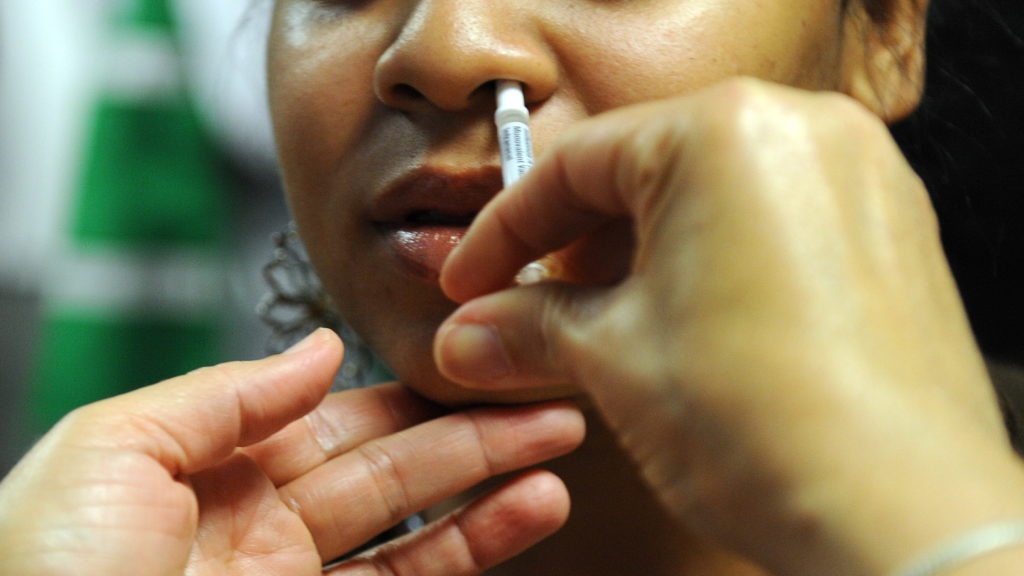People eligible to use the only needle-free flu vaccine available in the United States may be able, next year, to give it to themselves or to eligible children at home.
AstraZeneca, which makes the vaccine FluMist, announced Tuesday it has submitted to the Food and Drug Administration a supplemental biologics license application that would allow for self-administration of the vaccine by people ages 18 through 49, and would allow people 18 and older to give the vaccine to eligible children. FluMist is only licensed for use in children and adults from the age of 2 to 49 years old.
advertisement
The application, which the FDA is considering, would not mean there would effectively be over-the-counter sales of FluMist, Lisa Glasser, head of AstraZeneca’s U.S. medical affairs for vaccines and immune therapies, told STAT in an interview. Rather, the vaccine, which must be stored at refrigerator temperatures, would be ordered and delivered under appropriate temperature controls, after consultation with a medical professional.
Glasser said the program, if approved, would not replace the option of getting FluMist in a doctor’s office or at a pharmacy, but would be another alternative for busy families. “It is meant to enhance the ability to access influenza vaccination,” she said. “That’s the goal.”
The FDA application was supported by data generated by a “usability study” that tested the likelihood that people could administer this vaccine effectively. Glasser said the study showed home administration is viable, but declined to disclose details of the study because its application is still before the FDA.
advertisement
“We really feel confident that people will be able to do it,” Glasser said, pointing to how people learned to use multiple types of home tests during the Covid-19 pandemic. “People did it. And they managed it. And they still do them. I think we learned something from that.”
A decision from the regulatory agency is expected during the first quarter of 2024. If the FDA approves AstraZeneca’s application, the self-administration option would be rolled out next autumn, in time for the 2024-25 flu season.
The product would come in a pre-filled syringe — without a needle — and with a raft of information about how the vaccine should be administered. FluMist, which is the only intranasal vaccine licensed for human use in the U.S., is puffed up a nostril.
The vaccine is widely hailed as an attractive alternative for needle-phobic children and adults, though some pediatricians admit some children don’t enjoy the intranasal administration process either.
Andrew Pavia, chief of the division of pediatric infectious diseases at the University of Utah and director of hospital epidemiology at Primary Children’s Medical Center in Salt Lake City, called the idea of home administration of FluMist interesting, but said there could be some issues around this approach.
“First is handling and maintenance since it needs to be refrigerated,” he said, though the temperature-controlled delivery side of the equation could mitigate much of the risk there. “The second is making sure that it gets up the child’s nose adequately. Both are probably manageable.”
Other questions about home use of the vaccine may relate to the ability to capture data on how well the vaccine is working — a critical question in light of the history of FluMist in this country.
Early enthusiasm for the vaccine led to a rare preferential recommendation for FluMist for children from the Advisory Committee on Immunization Practices in 2014. ACIP advises the Centers for Disease Control and Prevention on vaccine use.
But data that emerged later from the 2013-14 and 2015-16 flu seasons led the ACIP to remove the preferential recommendation, because of questions about how well FluMist was protecting against influenza A H1N1 viruses. By 2016-17, the ACIP removed its recommendation for use of FluMist entirely and the company worked to reformulate that component of the quadrivalent (four-in-one) vaccine.
In 2018-19, ACIP restored its recommendation for FluMist use, based on a study done on the revised formulation. But the American Academy of Pediatrics that year said it wasn’t yet satisfied the problem had been solved and advised parents to use injectable vaccines for their children unless their child would not be vaccinated with a needle.
Glasser said she could not explain yet how use of the vaccine would be documented to ensure vaccine effectiveness data could still be generated, but said there will be a system in place.
“In terms of documentation of receipt of a vaccine, I can’t give you details right now exactly how that will happen. But it will not be disadvantaged by people taking FluMist for self administration. There will be appropriate recording of receipt of this vaccine,” she said.
FluMist’s return to the U.S. market occurred shortly before the arrival of the Covid-19 pandemic, which has led to an overall decline in the use of flu vaccine. Glasser said AstraZeneca expects to provide 1.5 million to 2 million doses of FluMist to the American market this year.

